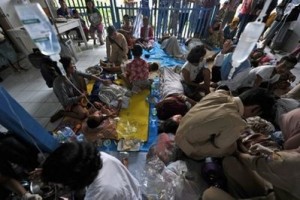In a hospital on a remote Indonesian island ravaged by this week’s tsunami, a 2-month-old boy orphaned by the big wave and found in a storm drain lay in a humidified crib, his lungs filled with fluid and cuts on his face.
“We need doctors, specialists,” nurse Anputra said, as the baby blinked sleepliy.
Dozens of wounded people lay on mats on the floor nearby, rain water dripping onto them from holes in the ceiling. Plastic ropes were strung between rafters and IV cords hung from them.

The death toll from the 10-foot-high (three-meter-high) tsunami that slammed into islands off western Indonesia rose to 370 on Friday as officials found more bodies, although hundreds of people remained missing. Harmensyah, head of the West Sumatra provincial disaster management center, said rescue teams “believe many, many of the bodies were swept to sea.”
Along with the 33 people killed by a volcano that erupted Tuesday more than 800 miles (1,300 kilometers) to the east in central Java, the number of dead from the twin disasters has now reached 426.
After a lull that allowed mourners to hold a mass burial for victims, Mount Merapi started rumbling again Thursday with three small eruptions and three others early Friday — easing pressure and possibly making another big eruption less likely. There were no reports of new injuries or damage.
The catastrophes struck within 24 hours in different parts of the seismically active country, severely testing Indonesia’s emergency response network.
Aid workers trickling into the remote region found giant chunks of coral and rocks in places where homes once stood. Huge swaths of land were submerged. Swollen corpses dotted roads and beaches.
Inside the tiny hospital on Pagai Utara — one of the four main islands in the Mentawai chain located between Sumatra and the Indian Ocean — 35-year-old Sarifinus cradled his 5-year-old, Dimas, who screamed as medical staff tended to his broken arm.
The man described how, when the towering wall of water came, he grabbed his two other young sons and ran toward the mountain. The wave tore both from his arms and sucked them away.
Sarifinus and his wife, Martina, who sat staring blankly in a corner of the hospital, found Dimas alive after the waters receded.
Around 100 survivors packed into a nearby, makeshift medical center.
Some still wept for lost loved ones as they lay on straw mats or sat on the floor, waiting for medics to treat injuries such as cuts and broken limbs. Outside, some rescuers wore face masks as they wrapped corpses in black body bags.
A young woman named Adek sobbed uncontrollably as she tried to talk about her year-old baby who was washed away. “Oh, don’t ask me again,” she said, wiping her tears and turning away.
One of the hardest hit areas with 65 dead was the village of Pro Rogat, on Pagai Seatandug island.
Villagers there huddled under tarps in the rain and told how many people who had fled to the hills were now too afraid to return home.
Mud and palm fronds covered the body of the village’s 60-year-old pastor, Simorangkir. He lay on the ground, partially zipped into a body bag. Police and relatives took turns pushing a shovel into the sodden dirt next to him for his grave.
His 28-year-old grandson, Rio, traveled by boat to Pro Rogat from his home on a nearby island to check on his relatives after the quake and tsunami. He said he was picking through the wreckage when someone cried out that he had found a body.
Rio walked over and saw the face of his dead grandfather, partially buried under several toppled palm trees, looking back at him.
“Everybody here is so sad,” Rio said, as relatives prepared to lay his grandfather in the grave.
At the Mount Merapi volcano, hot clouds of ash spewed from the mountain at 6:10 a.m., 8:40 a.m. and 11:19 Friday, according to Subandriyo, a senior government volcanologist.
The activity appeared to be easing pressure behind a lava dome that has formed in the crater, said Safari Dwiyono, a scientist who has been monitoring Merapi for 15 years.
“If the energy continues to release little by little like this, it reduces the chances of having a bigger, powerful eruption,” he said.
Residents from Kinahrejo, Ngrangkah, and Kaliadem — villages that were devastated in Tuesday’s blast — crammed into refugee camps. Officials brought cows, buffalo and goats down the mountain so that villagers wouldn’t try to go home to check on their livestock.
Thousands attended a mass burial for 26 of the victims six miles (10 kilometers) from the base of the volcano. Family and friends wept and hugged one another as the bodies were lowered into the grave in rows. AP

Leave a Reply
You must be logged in to post a comment.